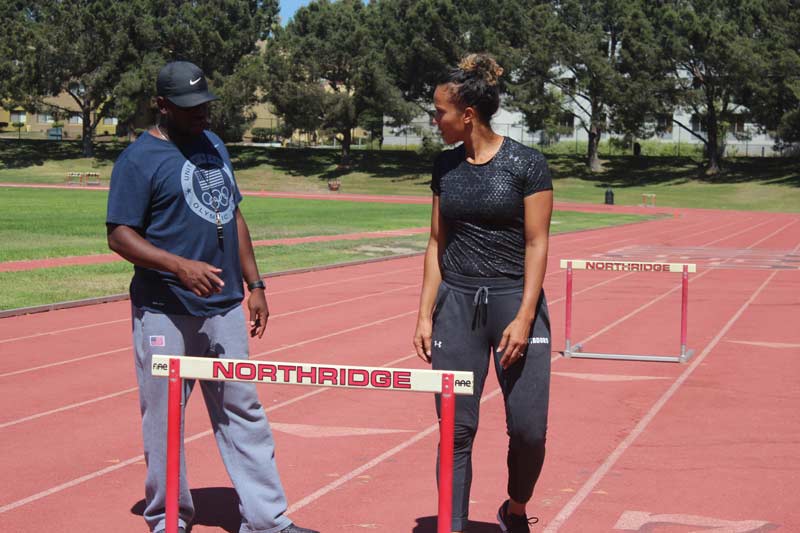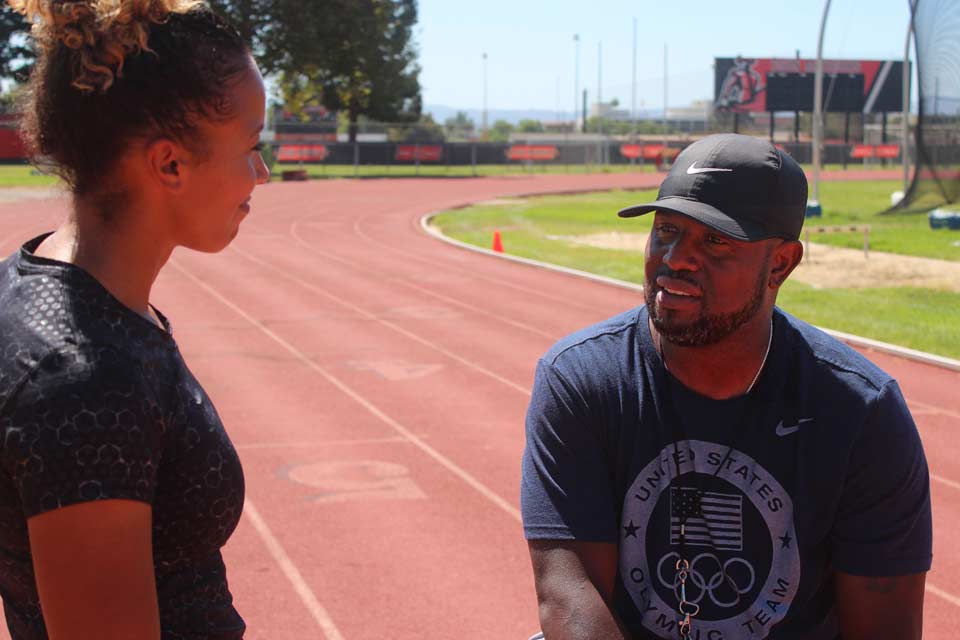When someone tells you who they are, listen. Lawrence “Boogie” Johnson—the 2013 USA Track & Field Coach of the Year and current Head Track & Field Coach for California State University, Northridge (CSUN)—has the bona fides to call himself whatever he chooses. Even as he trains a crew of notable Olympians, including 2016 Rio medalists Brianna McNeal (formerly Rollins), Dalilah Muhammad, and Kristi Castlin, rather than bill himself as an expert or a master or an elite instructor, Coach Johnson instead self-identifies by a far more humble and specialized term: The Hurdle Mechanic.
“I look at myself as one of those NASCAR mechanics, right?” Johnson says. “So every time they come back off of a big race, we get up under the hood to see what makes the car run better, what makes it run faster, what helps the driver become more efficient. Every pit stop has the same goals too—every pit stop, [that NASCAR crew] is looking at the car, how can the car run better? If you do this on turn two, you’re going to go faster… but on turn three, it’s better if you do this.”
[av_button_big label=’More track and field:’ description_pos=’below’ link=’manually,https://1080motion.com/defying-gravity-caryl-smith-gilbert/’ link_target=” icon_select=’no’ icon=’ue800′ font=’entypo-fontello’ custom_font=’#ffffff’ color=’theme-color’ custom_bg=’#444444′ color_hover=’theme-color-subtle’ custom_bg_hover=’#444444′ av_uid=’av-12c9gz7′]
Lessons in Defying Gravity with Coach Caryl Smith Gilbert
[/av_button_big]
For Coach Johnson, that mechanic’s mentality runs deeper than simply performing the routine tasks of a fix-it specialist or rolling up his sleeves to do the dirty work. The hurdles are, in Johnson’s words, “a very unique event that requires a very unique skill set.” Preparing athletes for those highly specialized demands requires the same element that makes all of us automobile owners stash the name of a reliable mechanic and pass it around like gold: Trust.
I. Believing In The Process
“I’m only able to be the best mechanic that I can be if the athletes trust me,” Johnson says. “It’s like us taking our car to the dealer and trusting that this person is doing the right thing for our car and is not overcharging us, and is properly certified, and is using the right parts and accessories to help us get the most out of the life of our car. It’s the same thing with the athletes. I gradually tweak and add things in, day-to-day, week-to-week, month-to-month, and year-to-year, things that are going to help them move closer and closer to perfection.”
The path to perfection in the hurdles is complicated: acceleration to max speed, timing and cadence, explosion and landing, return to max speed… within this combination of intricate mechanical demands, Johnson works to keep things simple. Efficiency is an objective both for his hurdlers on race day and in his own training methods—frequently, this means providing the athlete a minimum of technical information to prevent over-thinking, a philosophy which calls upon the athletes to trust that his guidance is on the mark.

“We talk all the time about how one thing we do talk about will fix two things we don’t. One good fix may fix two other things that I never even have to have a discussion with the athlete about,” Johnson says. “That’s the goal with the physical, keeping things very simple. Keeping things so that the athlete is spending time being competitive and racing and not overthinking things. In order to keep things simple, I may use one tool that’s actually going to eliminate problems in another couple areas, issues they have no clue they even need fixing. I’m trying to limit the information I give them for that reason, because an athlete has to really submit themselves to the coach and their teachers in order for them to be as successful as they can be.”
Simple enough? Except earning trust is an incremental process, compounded by the fact that Coach Johnson’s methodology is based on deliberate, gradual progressions. And, he happens to be working with athletes biologically hard-wired to go really fast.
II. The Right Tool At The Right Time
Pulling up at a new shop, how do you know if you’ve found a reputable mechanic? Start by taking a good look at their tools. Mechanics who take pride in their profession will invest in the best tools and the training needed to master and maintain them—skillful use of those implements allows that mechanic to produce the performance outcomes that serve as their stock and trade.
“A lot of times, people use the 1080 Sprint to help the athletes they work with run faster, but you have to use it in addition to coaching, not as the coach. People don’t always get the best use out of the device all the time, because they’re not using it for what it was intended for as a coaching aid… and the 1080 is probably one of the greatest coaching aids that I’ve ever come across, in terms of what it does and how it can help you.”
For Johnson, that means he doesn’t merely hook his athletes up to a resistance or assistance cable and expect instant results. Whether focusing on start work or trail leg action, everything’s gradual, everything’s a progression.
“When Dalilah (Muhammad) came to me in an Olympic year, we spent a lot of time working on the way that she was taking off from the ground and talking about the things she was doing on the backside of the hurdle. It’s a progression,” Johnson says. “I don’t want to move too fast. I want to make sure everything is in its right place and in its right time, and it worries me if I don’t think an athlete is grasping the concept that I want them to grasp in the way that I need them to grasp it. I don’t want to move too fast, because then it won’t stick.”
Properly applied, technology can provide invaluable information. If a coach is not prepared to use the captured data to support decision-making, however, then that cutting-edge technology is just another tool adding background noise to the buzz and whir in an already-busy shop.
“If I’m doing some resistance work, I record everything, I chart it,” Johnson says, discussing how he applies the 1080 Sprint. “For example, if we have it on three kilos of resistance for an athlete like Brianna McNeal, once she starts obliterating the times that she’s done in the past for ten meters, then we know we’re ready to go up to maybe four kilograms in weight for resistance, out to fifteen meters. So I add weight and I add distance.
“Keeping up on those things and charting those things gives you the most accuracy in terms of when to move up, because otherwise it’s just a guessing game. So, now I have numbers to compare to. I can look at Power Output, Meters Per Second, and I say now, after taking more weight out to fifteen meters, I’m going to make sure that things didn’t change. In that example, I put more weight on it because her numbers said she was ready to move on, but did adding distance change things? Did the numbers move? Is it a physical thing? Is it a mental thing? You get so much information if you chart it out that you’ll know right away when you need to move forward. And if you know when you need to move forward with things, that makes you the best coach, that makes you that much smarter than everyone else because they’re just guessing!”
III. High Performance Models
While the ultimate goal is always the same—go faster—Johnson plies his tools differently with each athlete or group of athletes, depending on their training history and program. For Brianna McNeal, an Olympic Gold winner in 2016, Johnson faced an unusual situation the following year, knowing that for procedural reasons the athlete would not be competing in 2017. Given that extra time, relieved of the pressure to be “race-ready” for a competitive season, Johnson and McNeal had an opportunity to experiment.
“We were able to utilize the 1080 Sprint a little bit more, it gave us an opportunity to really work out any kinks in terms of us knowing how to use the device the most effectively,” Johnson says. “It gave us the opportunity to truly take our time, spending an unreasonable amount of focus in certain areas that in a competitive season you don’t have the time to do. We spent a lot of time with her on the resistance part of the 1080, working on small things, shoring up the first couple steps. You only have two opportunities in a hurdle race to sprint—your first eight steps and the last six. So we need to make sure those opportunities are lined up in a way that we’re efficient.”
That focus and fine-tuning process paid off – McNeal won the 2018 Diamond League 100 M Hurdle final in a photo finish in Brussels in early September, with her time of 12.61 just two hundredths of a second ahead of Keni Harrison. This result following a stretch which included Diamond League race wins in Shanghai (May) Stockholm (June), and Rabat (July).
[av_button_big label=’Next post:’ description_pos=’below’ link=’manually,https://1080motion.com/power-gains-long-drive-ryan-steenberg/’ link_target=” icon_select=’no’ icon=’ue800′ font=’entypo-fontello’ custom_font=’#ffffff’ color=’theme-color’ custom_bg=’#444444′ color_hover=’theme-color-subtle’ custom_bg_hover=’#444444′ av_uid=’av-rd1xmb’]
Next Level Power Gains with Long Driver Ryan Steenberg
[/av_button_big]
For McNeal, Muhammad, and his professional hurdlers, Johnson uses the 1080 Sprint to specifically individualize his training; for his less-polished college athletes at CSUN, on the other hand, he introduces the technology as a part of a general, long-term development plan. Slow and steady—with a goal in mind that the athletes need to be able to hit key markers and benchmarks before moving on to any subsequent phases in the program.
“Everything we do with the college kids is rudimentary, and what I really want to be able to do with them is progress them over four years using the device. No matter where you are your freshman year, I may say three kilos [of resistance] is your max and you may keep doing three. And the girls who were on three last year, they’re all on four this year. And we haven’t moved from there—they just keep doing four better.
“Their assisted work is the same. If it’s three on the resisted, it’s three on the assisted. And say we’re doing a thirty meter fly, I only use the assisted on the fly-in… they have to do the thirty on their own. So, I guarantee the set-up, and then the athlete has to do the work. It doesn’t pull them through the run… they don’t get the full pull all the way through. You got to do your own cooking (laughs). I’ll help you with the setup, but you got to do your own cooking.”






























































